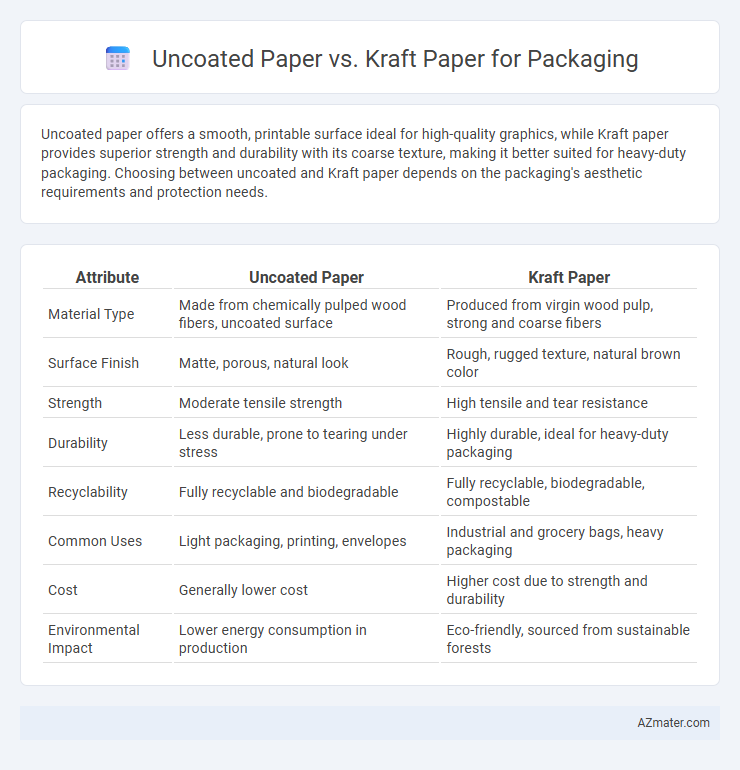Uncoated paper offers a smooth, printable surface ideal for high-quality graphics, while Kraft paper provides superior strength and durability with its coarse texture, making it better suited for heavy-duty packaging. Choosing between uncoated and Kraft paper depends on the packaging's aesthetic requirements and protection needs.
Table of Comparison
| Attribute | Uncoated Paper | Kraft Paper |
|---|---|---|
| Material Type | Made from chemically pulped wood fibers, uncoated surface | Produced from virgin wood pulp, strong and coarse fibers |
| Surface Finish | Matte, porous, natural look | Rough, rugged texture, natural brown color |
| Strength | Moderate tensile strength | High tensile and tear resistance |
| Durability | Less durable, prone to tearing under stress | Highly durable, ideal for heavy-duty packaging |
| Recyclability | Fully recyclable and biodegradable | Fully recyclable, biodegradable, compostable |
| Common Uses | Light packaging, printing, envelopes | Industrial and grocery bags, heavy packaging |
| Cost | Generally lower cost | Higher cost due to strength and durability |
| Environmental Impact | Lower energy consumption in production | Eco-friendly, sourced from sustainable forests |
Introduction to Packaging Paper Types
Uncoated paper and Kraft paper are two common types of packaging materials distinguished by their texture, strength, and production process. Uncoated paper offers a smooth, porous surface ideal for printing and lightweight packaging, whereas Kraft paper is known for its durability and high tear resistance due to its long fibers and minimal processing. Both materials serve crucial roles in sustainable packaging solutions, with Kraft paper often preferred for heavy-duty applications and uncoated paper chosen for eco-friendly, printable packaging.
What is Uncoated Paper?
Uncoated paper is a type of paper that lacks a surface coating, giving it a natural, porous texture ideal for printing and writing applications where absorbency is essential. It is commonly used in packaging for products requiring breathability and eco-friendly attributes, as it is recyclable and biodegradable. Uncoated paper contrasts with kraft paper, which is thicker, stronger, and made from chemical pulp, making kraft paper more suitable for heavy-duty packaging needs.
What is Kraft Paper?
Kraft paper is a durable, coarse paper produced from chemical pulp derived from softwood trees, known for its high tear resistance and strength, making it ideal for packaging heavy or abrasive items. Unlike uncoated paper, which is typically smoother and less robust, Kraft paper offers excellent protection against moisture and punctures due to its natural lignin content and dense fiber structure. Its eco-friendly properties and recyclability enhance its popularity in sustainable packaging solutions.
Key Differences: Uncoated vs Kraft Paper
Uncoated paper is smooth, lightweight, and ideal for printing and packaging that requires high-quality graphics, while Kraft paper is thicker, stronger, and designed for heavy-duty packaging and durability. Uncoated paper typically has a natural white or cream appearance and absorbs ink readily, whereas Kraft paper has a distinctive brown color due to minimal processing and excels in tear resistance. Packaging applications often choose uncoated paper for aesthetic appeal and Kraft paper for strength and environmental sustainability.
Strength and Durability Comparison
Uncoated paper exhibits moderate strength and tear resistance, making it suitable for lightweight packaging but less effective in protecting heavier or sharp-edged items. Kraft paper, derived from chemical pulp, offers superior tensile strength and durability due to its long fibers and dense texture, providing enhanced protection in industrial and heavy-duty packaging applications. The natural lignin content in kraft paper also contributes to its robustness, making it more resistant to punctures and abrasion compared to uncoated paper.
Environmental Impact and Sustainability
Uncoated paper and Kraft paper significantly differ in environmental impact and sustainability, with Kraft paper being more eco-friendly due to its production from unbleached, recycled wood fibers and its biodegradability. Uncoated paper, often made from virgin fibers without chemical treatments, can require more intensive resource use and produce higher emissions during manufacturing. Kraft paper's durability and recyclability make it a preferred choice for sustainable packaging solutions aiming to reduce carbon footprint and waste.
Printability and Branding Potential
Uncoated paper offers superior printability with vibrant color reproduction and fine detail, making it ideal for high-quality branding and intricate designs. In contrast, kraft paper provides a rustic, natural aesthetic with moderate print clarity, enhancing eco-friendly brand appeal but limiting detailed graphic elements. Brands targeting premium visual impact tend to favor uncoated paper, whereas those emphasizing sustainability and rugged authenticity prefer kraft paper.
Cost Considerations in Packaging
Uncoated paper generally offers lower initial costs compared to kraft paper, making it a budget-friendly option for lightweight packaging needs. Kraft paper, while typically more expensive, provides superior strength and durability, reducing potential packaging damage and associated replacement costs. Evaluating the total cost of ownership, including material, protection level, and sustainability, helps determine the most cost-effective choice for packaging applications.
Ideal Applications for Each Paper Type
Uncoated paper is ideal for packaging products requiring high-quality printing and a smooth surface, such as retail boxes, greeting cards, and luxury product packaging due to its excellent ink absorption and vibrant color reproduction. Kraft paper excels in heavy-duty applications like industrial packaging, grocery bags, and shipping envelopes, offering superior strength, tear resistance, and eco-friendliness from its natural wood pulp fibers. Choosing between uncoated and kraft paper depends on the packaging's durability needs and the desired visual presentation.
Choosing the Right Paper for Your Packaging Needs
Uncoated paper offers a smooth, natural surface ideal for detailed printing and high-quality graphics, making it perfect for premium product packaging that requires a refined appearance. Kraft paper provides exceptional strength and durability with its coarse texture, suited for heavy-duty packaging and eco-friendly brands emphasizing recyclability and robustness. Selecting between uncoated and kraft paper depends on your packaging goals, balancing visual appeal, protection needs, and environmental considerations.

Infographic: Uncoated paper vs Kraft paper for Packaging
 azmater.com
azmater.com